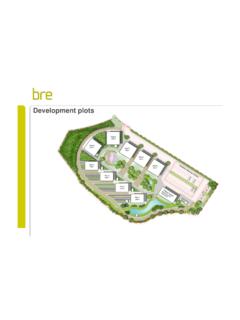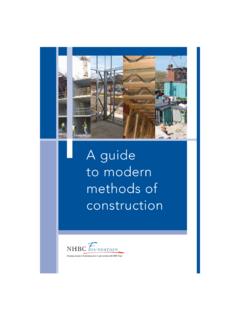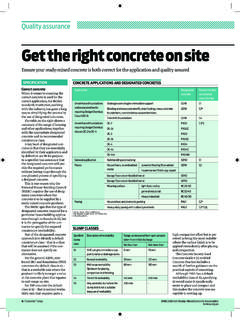Transcription of Guidance on the assessment of dust from …
1 IAQM u Guidance construction DustGuidance on the assessment of dust from demolition and MGMUDNCE oDnGst 1 15/01/2015 15:17 Version u Guidance construction Dust2 Acknowledgements 31. Introduction 42. Terminology 63. Background 84. Potential Impacts 95. assessment Procedure 116. STEP 1: Screen the Need for a Detailed assessment 137. STEP 2: Assess the Risk of dust Impacts Arising 148. STEP 3: Site-specific Mitigation 239. STEP 4: Determine Significant Effects 2810. STEP 5: dust assessment Report 2911. Professional Judgement 30 Table 1: Example of the How the dust Emission Magnitude for a Site Could be Presented 16 Table 2: Sensitivity of the Area to dust Soiling Effects on People and Property 19 Table 3: Sensitivity of the Area to Human Health Impacts 20 Table 4: Sensitivity of the Area to Ecological Impacts 21 Table 5: Example of the Outcome of Defining the Sensitivity of the Area 21 Table 6: Risk of dust Impacts - demolition 21 Table 7: Risk of dust Impacts - Earthworks 21 Table 8: Risk of dust Impacts - construction 22 Table 9: Risk of dust Impacts - Trackout 22 Table 10: Example of a Summary dust Risk Table to Define Site-Specific Mitigation 23 Figure 1: Steps to Perform a dust assessment 12 Figure 2: Responsibilities for dust Mitigation from demolition and construction sites 23 Box 1: Screening Criteria 13 Box 2.
2 Technical Competency of Assessor 14 Box 3: Crushing and Screening 15 Box 4: Concrete Batching Plant 15 Box 5: Importance of dust Raised by Vehicles 15 Box 6: Sensitivities of People to dust Soiling Effects 16 Box 7: Sensitivities of People to the Health Effects of PM10 23 Box 8: Sensitivities of Receptors to Ecological Effects 24 Box 9: Additional Factors to Consider when Determining the Sensitivity of the Area 25 ContentsIAQM Guidance on the assessment of dust from demolition and construction 3 IAQM u Guidance construction DustAcknowledgementsAcknowledgements: This Guidance was produced as a result of the voluntary contribution of the members of a Working Group, for which IAQM is very grateful. This Guidance represents the views of the IAQM and not necessarily the individual members of the working group. Chair of the working group Dr Claire Holman, Brook Cottage ConsultantsMembersRoger Barrowcliffe, Clear Air Thinking Daniel Birkenshaw, Golder AssociatesHannah Dalton, RambollDr Garry Gray, URSG raham Harker, Peter Brett Associates LLPProf.
3 Duncan Laxen, Air Quality Consultants Dr Ben Marner, Air Quality Consultants Daniel Marsh, Kings College London Fiona Prismall, RPS Planning & DevelopmentDr Jon Pullen, RPS Planning & DevelopmentMatthew Stoaling, SLR Consulting LtdCatherine Storey, Independent Environmental ConsultantLesley Vining, ENVIRON UKGraphic Design: Darren Walker ( )Suggested citatation: Holman et al (2014). IAQM Guidance on the assessment of dust from demolition and contstruction, Institute of Air Quality Management, London. the Institute of Air Quality Management (IAQM): The IAQM aims to be the authoritative voice for air quality by maintaining, enhancing and promoting the highest standards of working practices in the field and for the professional development of those who undertake this work. Membership of IAQM is mainly drawn from practicing air quality professionals working within the fields of air quality science, air quality assessment and air quality management.
4 Front cover photo: Hannah DaltonCopyright statement: Copyright of these materials is held by IAQM. We encourage the use of the materials but request that acknowledgement of the source is explicitly : IAQMc/o Institution of Environmental Sciences 140 London Wall London, EC2Y 5DN T: +44 (0) 20 7601 1920 E: Publication Date: February 2014 This document is available for download from the IAQM website ( ) together with examples of the use of the 01/06/16 - Alterations to Table u Guidance construction Dust41. IntroductionEmissions of dust to air can occur during the preparation of the land ( demolition , land clearing, and earth moving), and during construction . Emissions can vary substantially from day to day, depending on the level of activity, the specific operations being undertaken, and the weather conditions. A large proportion of the emissions result from site plant and road vehicles moving over temporary roads and open ground.
5 If mud is allowed to get onto local roads, dust emissions can occur at some distance from the originating site. The scale of these impacts depends on the dust suppression and other mitigation measures terms of effects, construction sites can give rise to annoyance due to the soiling of surfaces by dust . Very high levels of soiling can also damage plants and affect the diversity of ecosystems. Additionally, there is evidence of major construction sites increasing long term particulate matter (PM10) concentrations1 and the number of days2 when PM10 concentrations exceed 50 g/m3, the daily limit value for this pollutant. Exposure to PM10 has long been associated with a range of health planning authorities often require the air quality impacts of new developments to be assessed as part of the decision making process4, either as a standalone document or as part of a wider Environmental Impact assessment (EIA).
6 The latter requires both the construction and operational phases of developments to be considered, and as a result many stand-alone air quality assessments also consider the impacts of both phases of new developments. In London the Mayor has recently introduced a requirement for construction impact assessments for major document is designed to provide Guidance for developers, their consultants and environmental health practitioners on how to undertake a construction impact assessment (including demolition and earthworks as appropriate). The construction impact assessment may be a standalone document (possibly including other environmental impacts such as noise) or incorporated into an Air Quality assessment or EIA. The impacts depend on the mitigation measures adopted. Therefore the emphasis in this document is on classifying the risk of dust impacts from a site, which will then allow mitigation measures commensurate with that risk to be identified.
7 In Environmental Statements (ESs) and Air Quality Assessments the terms impacts and effects are often used interchangeably. In this document the term impact has been used to describe a change in concentration or dust deposition and effect to describe the consequences of any operational phases of minerals (and some waste) sites share some common features with construction activities; however, minerals sites can be of a significantly larger scale. A qualitative dust assessment for a minerals site would therefore normally be expected to be at least as rigorous as one carried out in accordance with the IAQM construction dust method, reflecting the potential for minerals sites to have a greater impact than construction sites. The underlying Source-Pathway-Receptor concept used in the IAQM construction dust method is applicable to a wide range of applications, including minerals developments; however, the detailed Guidance in this document (particularly on source strength and pathway distances) is specifically for construction and demolition and cannot be used, without appropriate modification, for other activities.
8 Notwithstanding this, and in the current absence of other detailed Guidance , the IAQM construction dust method can be taken as a starting point for a minerals dust assessment provided it is used with appropriate modifications to the various terms and factors; some aspects of this Guidance , such as the assessment of dust from earthworks and track-out, may be applicable with only minor adjustments. It is the intention of the IAQM to produce separate Guidance on the assessment of the impact of mineral and waste sites at a future date. This Guidance is aimed primarily for use in the UK, where the vast majority of IAQM members work. However, it is recognised that the membership of IAQM is international and that the Guidance may be applied elsewhere. Where this occurs careful consideration should to be given to its applicability where there are different climates, construction working practices and statutory assessment criteria.
9 As stated above, the emphasis has been on classifying demolition and construction sites according to the risk of impacts, to identify mitigation measures appropriate to the risk. It is anticipated that with the implementation of effective site-specific mitigation measures the environmental effect will not be significant in most IAQM Guidance on the assessment of dust from demolition and construction 5 IAQM u Guidance construction DustThis Guidance represents an update of the 2012 IAQM publication6. The Guidance will continue to be updated as knowledge regarding its use expands and as a result of legislative or other requirements. The user should therefore check the IAQM website ( ) to ensure that the latest Guidance is being Nonetheless a robust assessment of the dust impact risk is necessary (and is described here) in order to determine the level of site-specific mitigation that should be Stuart Upton and Vina Kukadia, 2004, Measurements of air pollution emissions from a construction site: a case study, Report for Greater London Authority, BRE Environment, Watford.
10 Air Quality Expert Group (AQEG), 2005, Particulate Matter in the UK, Section construction Activities. 2 Gary D Fuller and David Green, 2004, The impact of local fugitive PM10 emissions from building works and road works on the assessment of the European Union limit value, Atmos-pheric Environment, 38, 4993-5002. 3 There is evidence that short-term exposure to coarse particles those between PM10 and , typically associated with demolition and con-struction activities, including crustal material, are associated with adverse respiratory and cardiovascular effects on health (World Health Organization, REVIHAAP Project: Technical Report, 2013, ). 4 For example, the National Planning Practice Guidance for England (Beta Ver-sion) includes air quality as a relevant considered in planning decisions and specifically includes significant impact (such as dust ) during construction for nearby sensitive locations.












